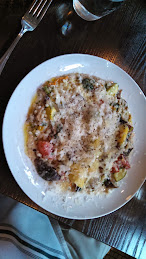I saw a version of this recipe in Food & Wine and had to try something that combines two of my daughter's favorite foods: crab and bread pudding. And come to think of it, those are two of mine, as well.
But the F&W recipe was called "Buttery Crab Bread Pudding," and contained not only more than a stick of butter but also a cup of half and half.
Here is a somewhat lighter version, still a rich meal -- and a great hit at dinner this past weekend!
Crab Bread Pudding
Serves 6
Ingredients:
One pound lump crabmeat
2 T chopped fresh parsley
2 T chopped chives
3 teaspoons fresh lemon juice
Dash of cayenne pepper (more or less, to taste)
Salt and freshly ground black pepper, to taste
Smart Balance or other plant-based, non-hydrogenated margarine
One 24-inch whole-grain baguette, or an equivalent amount of crusty, whole-grain bread (somewhat stale bread works best), cut into uniform, 3/4-inch thick slices
5 large eggs
1 1/2 cups whole milk
1 cup fat-free half-and-half
Instructions:
Preheat oven to 350 degrees and grease a 9-by-13-inch baking dish. (Use cooking spray, or some of the margarine, or even a little bit of butter)
In a medium bowl, toss the crabmeat with the parsley, chives, lemon juice and cayenne. Season with a dash of salt and pepper. (Don't overdo the salt.)
Spread each slice of bread with a little margarine and stand up the slices in the prepared baking dish. Spoon the crab mixture evenly between the bread slices.
In a bowl, whisk the eggs with the milk, half-and-half, and a little salt and pepper. Pour the custard evenly over the bread and let stand for 10-15 minutes.
Bake the bread pudding for 30 minutes, until the top is lightly browned and the custard is set.
Let stand for 10 minutes before serving.
Note: This dish goes perfectly with a French chardonnay, or one from California that isn't too oaky.
Panera Chicken Bacon Rancher
16 hours ago
























